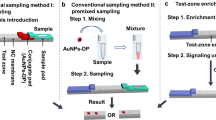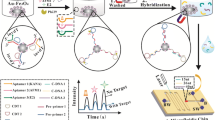Abstract
Here, an enzyme-free lateral flow aptasensor was designed by target-induced strand-displacement effect and followed by the activation of multi-component nucleic acid enzyme (MNAzyme)-mediated cleavage to enable rapid and portable ochratoxin A (OTA) detection. The substrate was prepared as an oligonucleotide strand modified with magnetic beads (MB) and human chorionic gonadotropin (hCG). The interaction of OTA with the aptamer induces the release of blocking DNA, which hybridized with three separated subunits of DNA, forming a sequence-specific MNAzyme catalytic core. This core subsequently initiated an enzyme-free MNAzyme cleavage reaction in the presence of the Mg2+ cofactor, cleaving a special substrate and releasing both the incomplete MNAzyme catalytic core and hCG-DNA probe. The incomplete MNAzyme catalytic core was then recognized by substrates once again, triggering a cascade recycling cleavage and resulting in the generation of a larger number of hCG-DNA probes. After magnetic enrichment, the free hCG-DNA probes flow through the pregnancy test strip (PTS) to the T line, generating a colorimetric readout that unequivocally confirms the presence of the target OTA. This work leverages the efficient enzyme-free cleavage amplification of MNAzyme and the PTS-based portable detection device, presenting a biosensing strategy with significant potential for sensitive and portable OTA detection. This method exhibited remarkable sensitivity and selectivity for OTA detection, boasting a detection limit of 5 nM. The present study successfully demonstrated the practical application of this method on real samples, offering a viable alternative for rapid and portable detection of mycotoxins.





Similar content being viewed by others
References
Du H, Li X, Xu S, Cheng G, Xue Q, Xu H. N/S-Co-doped carbon dot–based FRET ratiometric fluorescence aptasensing platform modulated with entropy-driven DNA amplifier for ochratoxin a detection. Anal Bioanal Chem. 2023;415(19):4649–60. https://doi.org/10.1007/s00216-023-04778-5.
Malir F, Ostry V, Pfohl-Leszkowicz A, Malir J, Toman J (2016) Ochratoxin A: 50 years of research. Toxins 8 (7). https://doi.org/10.3390/toxins8070191
He Z, Chen Q, Ding S, Wang G, Takarada T, Maeda M. Suppressed DNA base pair stacking assembly of gold nanoparticles in an alcoholic solvent for enhanced ochratoxin A detection in Baijiu. Analyst. 2023;148(6):1291–9. https://doi.org/10.1039/D3AN00016H.
Zhang H, Wang Y, Lin Y, Chu W, Luo Z, Zhao M, Hu J, Miao X, He F. A catalytic hairpin assembly–based Förster resonance energy transfer sensor for ratiometric detection of ochratoxin A in food samples. Anal Bioanal Chem. 2023;415(5):867–74. https://doi.org/10.1007/s00216-022-04479-5.
Yang Y, Li G, Wu D, Liu J, Li X, Luo P, Hu N, Wang H, Wu Y. Recent advances on toxicity and determination methods of mycotoxins in foodstuffs. Trends Food Sci Technol. 2020;96:233–52. https://doi.org/10.1016/j.tifs.2019.12.021.
Zhu CX, Liu D, Li YY, Ma S, Wang M, You TY (2021) Hairpin DNA assisted dual-ratiometric electrochemical aptasensor with high reliability and anti-interference ability for simultaneous detection of aflatoxin B1 and ochratoxin A. Biosens. Bioelectron. 174. https://doi.org/10.1016/j.bios.2020.112654
Xie X, He Z, Qu C, Sun Z, Cao H, Liu X. Nanobody/NanoBiT system-mediated bioluminescence immunosensor for one-step homogeneous detection of trace ochratoxin A in food. J Hazard Mater. 2022;437: 129435. https://doi.org/10.1016/j.jhazmat.2022.129435.
Yang Y, Su Z, Wu D, Liu J, Zhang X, Wu Y, Li G (2022) Low background interference SERS aptasensor for highly sensitive multiplex mycotoxin detection based on polystyrene microspheres-mediated controlled release of Raman reporters. Anal Chim Acta 1218. https://doi.org/10.1016/j.aca.2022.340000
Zong C, Jiang F, Wang X, Li P, Xu L, Yang H (2021) Imaging sensor array coupled with dual-signal amplification strategy for ultrasensitive chemiluminescence immunoassay of multiple mycotoxins. Biosens. Bioelectron. 177. https://doi.org/10.1016/j.bios.2021.112998
Yang Y, Wu D, Liu J, Su Z, Li L, Wu Y, Li G (2022) High-efficiency enzyme-free catalyzed hairpin assembly-mediated homogeneous SERS and naked-eyes dual-mode assay for ultrasensitive and portable detection of mycotoxin. Biosens Bioelectron. 214. https://doi.org/10.1016/j.bios.2022.114526
Huang Q, Yang H, Wang W, Zhang Y. Multi-target photothermal immunochromatography for simultaneous detection of three mycotoxins in foods. Anal Chim Acta. 2023;1279: 341784. https://doi.org/10.1016/j.aca.2023.341784.
Schax E, Loenne M, Scheper T, Belkin S, Walter J-G. Aptamer-based depletion of small molecular contaminants: a case study using ochratoxin A. Biotechnol Bioprocess Eng. 2015;20(6):1016–25. https://doi.org/10.1007/s12257-015-0486-1.
Tang Y, Qi L, Liu Y, Guo L, Zhao R, Yang M, Du Y, Li B (2022) CLIPON: a CRISPR-enabled strategy that turns commercial pregnancy test strips into general point-of-need test devices. Angew Chem Int Ed. 61(12). https://doi.org/10.1002/anie.202115907
Rivas L, de la Escosura-Muniz A, Serrano L, Altet L, Francino O, Sanchez A, Merkoci A. Triple lines gold nanoparticle-based lateral flow assay for enhanced and simultaneous detection of Leishmania DNA and endogenous control. Nano Res. 2015;8(11):3704–14. https://doi.org/10.1007/s12274-015-0870-3.
Qi L, Yang M, Chang D, Zhao W, Zhang S, Du Y, Li Y. A DNA nanoflower-assisted separation-free nucleic acid detection platform with a commercial pregnancy test strip. Angew Chem Int Ed. 2021;60(47):24823–7. https://doi.org/10.1002/anie.202108827.
Yang M, Tang Y, Qi L, Zhang S, Liu Y, Lu B, Yu J, Zhu K, Li B, Du Y. SARS-CoV-2 point-of-care (POC) diagnosis based on commercial pregnancy test strips and a palm-size microfluidic device. Anal Chem. 2021;93(35):11956–64. https://doi.org/10.1021/acs.analchem.1c01829.
Wang XK, Wang XD, Shi C, Ma CP, Chen LX (2020) Highly sensitive visual detection of nucleic acid based on a universal strand exchange amplification coupled with lateral flow assay strip. Talanta 216. https://doi.org/10.1016/j.talanta.2020.120978.
Zhong ZT, Song LB, Li CQ, Sun X, Chen W, Liu B, Zhao YD (2021) Lateral flow biosensor for universal detection of various targets based on hybridization chain reaction amplification strategy with pregnancy test strip. Sens Actuators B 337. https://doi.org/10.1016/j.snb.2021.129778.
Zhang Y, Ma CB, Yang MT, Pothukuchy A, Du Y. Point-of-care testing of various analytes by means of a one-step competitive displacement reaction and pregnancy test strips. Sens Actuators B. 2019;288:163–70. https://doi.org/10.1016/j.snb.2019.02.091.
Zhong ZT, Wang HB, Zhang T, Li CQ, Liu B, Zhao YD (2021) Quantitative analysis of various targets based on aptamer and functionalized Fe3O4@graphene oxide in dairy products using pregnancy test strip and smartphone. Food Chem. 352. https://doi.org/10.1016/j.foodchem.2021.129330.
Du Y, Pothukuchy A, Gollihar JD, Nourani A, Li B, Ellington AD. Coupling sensitive nucleic acid amplification with commercial pregnancy test strips. Angew Chem Int Ed. 2017;56(4):992–6. https://doi.org/10.1002/anie.201609108.
Xu QF, Zhang Y, Xiang DX, Li CC, Zhang CY. A universal DNAzyme-based bioluminescent sensor for label-free detection of biomolecules. Analy Chim Acta. 2018;1043:81–8. https://doi.org/10.1016/j.aca.2018.08.059.
Khan S, Burciu B, Filipe CDM, Li Y, Dellinger K, Didar TF. DNAzyme-based biosensors: immobilization strategies, applications, and future prospective. ACS Nano. 2021;15(9):13943–69. https://doi.org/10.1021/acsnano.1c04327.
Xie YM, Niu FN, Yu AM, Lai GS. Proximity binding-triggered assembly of two MNAzymes for catalyzed release of G-quadruplex DNAzymes and an ultrasensitive homogeneous bioassay of platelet-derived growth factor. Anal Chem. 2020;92(1):593–8. https://doi.org/10.1021/acs.analchem.9b05002.
Li XM, Cheng W, Li DD, Wu JL, Ding XJ, Cheng Q, Ding SJ. A novel surface plasmon resonance biosensor for enzyme-free and highly sensitive detection of microRNA based on multi component nucleic acid enzyme (MNAzyme)-mediated catalyzed hairpin assembly. Biosens Bioelectron. 2016;80:98–104. https://doi.org/10.1016/j.bios.2016.01.048.
Mokany E, Bone SM, Young PE, Doan TB, Todd AV. MNAzymes, a versatile new class of nucleic acid enzymes that can function as biosensors and molecular switches. J Am Chem Soc. 2010;132(3):1051–9. https://doi.org/10.1021/ja9076777.
Wang Y, Nguyen K, Spitale RC, Chaput JC (2021) A biologically stable DNAzyme that efficiently silences gene expression in cells. Nat Chem 13(4). https://doi.org/10.1038/s41557-021-00645-x.
Hanpanich O, Oyanagi T, Shimada N, Maruyama A (2019) Cationic copolymer-chaperoned DNAzyme sensor for microRNA detection. Biomaterials. 225. https://doi.org/10.1016/j.biomaterials.2019.119535.
Peng HY, Newbigging AM, Wang ZX, Tao J, Deng WC, Le XC, Zhang HQ. DNAzyme-mediated assays for amplified detection of nucleic acids and proteins. Analy Chem. 2018;90(1):190–207. https://doi.org/10.1021/acs.analchem.7b04926.
Wu D, Wang Y, Zhang Y, Ma H, Pang X, Hu L, Du B, Wei Q. Facile fabrication of an electrochemical aptasensor based on magnetic electrode by using streptavidin modified magnetic beads for sensitive and specific detection of Hg2+. Biosens Bioelectron. 2016;82:9–13. https://doi.org/10.1016/j.bios.2016.03.061.
Mohamed MAA, Kozlowski HN, Kim J, Zagorovsky K, Kantor M, Feld JJ, Mubareka S, Mazzulli T, Chan WCW. diagnosing antibiotic resistance using nucleic acid enzymes and gold nanoparticles. ACS Nano. 2021;15(6):9379–90. https://doi.org/10.1021/acsnano.0c09902.
Cairns MJ, King A, Sun L-Q. Optimisation of the 10–23 DNAzyme-substrate pairing interactions enhanced RNA cleavage activity at purine-cytosine target sites. Nucleic Acids Res. 2003;31(11):2883–9. https://doi.org/10.1093/nar/gkg378.
Li T, Su Z, Li Y, Xi L, Li G (2022) An aptamer-assisted biological nanopore biosensor for ultra-sensitive detection of ochratoxin A with a portable single-molecule measuring instrument. Talanta. 248. https://doi.org/10.1016/j.talanta.2022.123619.
Zhong ZT, Song LB, He YF, Zhang B, Chen W, Liu B, Zhao YD (2022) Detection of multiple mycotoxins based on catalytic hairpin assembly coupled with pregnancy test strip. Sensors Actuators B 350. https://doi.org/10.1016/j.snb.2021.130911.
Xu G, Zhao J, Yu H, Wang C, Huang Y, Zhao Q, Zhou X, Li C, Liu M. Structural insights into the mechanism of high-affinity binding of ochratoxin A by a DNA aptamer. J Am Chem Soc. 2022;144(17):7731–40. https://doi.org/10.1021/jacs.2c00478.
Cruz-Aguado JA, Penner G. Determination of ochratoxin A with a DNA aptamer. J Agric Food Chem. 2008;56(22):10456–61. https://doi.org/10.1021/jf801957h.
Xiang Y, Belen Camarada M, Wen Y, Wu H, Chen J, Li M, Liao X. Simple voltammetric analyses of ochratoxin A in food samples using highly-stable and anti-fouling black phosphorene nanosensor. Electrochim Acta. 2018;282:490–8. https://doi.org/10.1016/j.electacta.2018.06.055.
Hu X, Xia Y, Liu Y, Chen Y, Zeng B. An effective ratiometric electrochemical sensor for highly selective and reproducible detection of ochratoxin A: use of magnetic field improved molecularly imprinted polymer. Sensors Actuators B. 2022;359:131582. https://doi.org/10.1016/j.snb.2022.131582.
Pacheco JG, Castro M, Machado S, Barroso MF, Nouws HPA, Delerue-Matos C. Molecularly imprinted electrochemical sensor for ochratoxin A detection in food samples. Sensors Actuators B. 2015;215:107–12. https://doi.org/10.1016/j.snb.2015.03.046.
Li S, Kang Y, Shang M, Cai Y, Yang Z. Highly sensitive and selective detection of Ochratoxin a using modified graphene oxide-aptamer sensors as well as application. Microchem J. 2022;179: 107449. https://doi.org/10.1016/j.microc.2022.107449.
Funding
This work was supported by the National Natural Science Foundation of China (32022069 and 22076115).
Author information
Authors and Affiliations
Corresponding author
Ethics declarations
Conflict of interest
The authors declare no competing interests.
Additional information
Publisher's Note
Springer Nature remains neutral with regard to jurisdictional claims in published maps and institutional affiliations.
Supplementary Information
Below is the link to the electronic supplementary material.
Rights and permissions
Springer Nature or its licensor (e.g. a society or other partner) holds exclusive rights to this article under a publishing agreement with the author(s) or other rightsholder(s); author self-archiving of the accepted manuscript version of this article is solely governed by the terms of such publishing agreement and applicable law.
About this article
Cite this article
Yang, Y., Shi, Y., Zhang, X. et al. MNAzyme catalyzed signal amplification-mediated lateral flow biosensor for portable and sensitive detection of mycotoxin in food samples. Anal Bioanal Chem 416, 1057–1067 (2024). https://doi.org/10.1007/s00216-023-05096-6
Received:
Revised:
Accepted:
Published:
Issue Date:
DOI: https://doi.org/10.1007/s00216-023-05096-6




